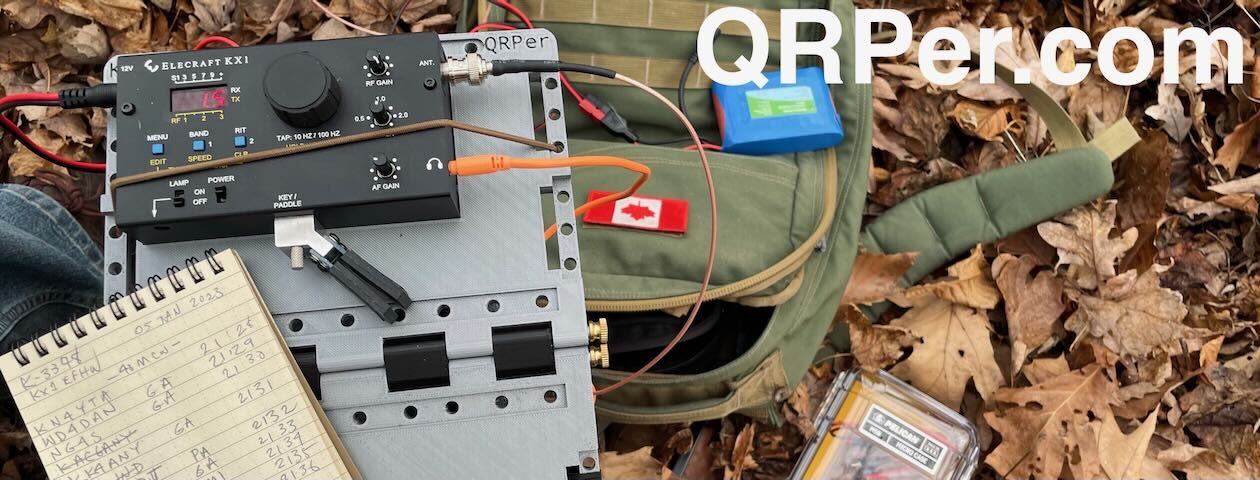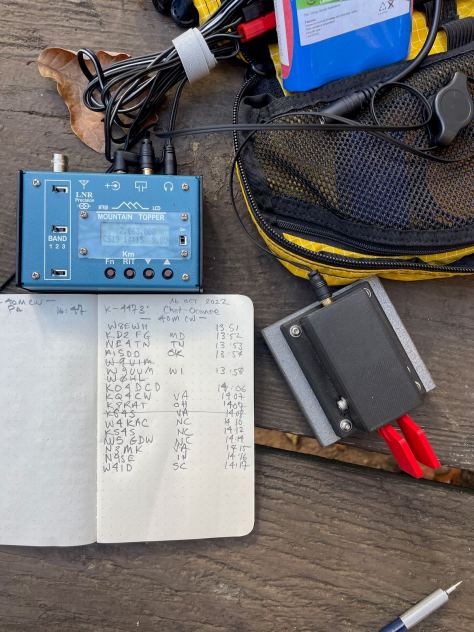
As I mentioned in previous field reports, the W4G SOTA Campout was amazing fun this year. I enjoyed hanging with Joshua (KO4AWH) as we activated a total of three summits and a few parks–plus it was great meeting so many fellow SOTA activators at the Saturday evening potluck!
On Sunday morning, October 16, 2022, it was time to pack up the campsite and hit the road.
Although I was a little pressed for time, I decided to fit in one more activation as Joshua packed up his tent and before we took down the 40 meter Tufteln end-fed half-wave.
Chattahoochee-Oconee National Forest (K-4473)
Fortunately, our campsite was within Chattahoochee-Oconee National Forest and since all I needed to do was to connect my rig to our campsite antenna, setup took all of two minutes.
I pulled out the Mountain MTR-3B for this activation. It had been quite some time since I used this wee radio because I had only recently finished a review of the MTR-4B V2 (look for that review on QRPer.com very soon).
The MTR-3B is now permanently at-the-ready inside my MTR-3B ultra portable field kit, but since there was already an antenna and key in place, I only needed the radio, power cord, logging items, and battery.
For my activation video, I decided to pair the MTR-3B with my Sony SRS-XB12 portable speaker instead of recording the audio separately on a digital recorder. This made recording the activation video much easier.
A note about scheduling POTA activations
 As I mention in the video, we had absolutely no cell phone or internet service at the campsite. I knew this would be the case in advance, so before leaving on my trip to north Georgia, I scheduled activations of K-4473 for each morning and evening of the camping trip.
As I mention in the video, we had absolutely no cell phone or internet service at the campsite. I knew this would be the case in advance, so before leaving on my trip to north Georgia, I scheduled activations of K-4473 for each morning and evening of the camping trip.
This is a very important step especially if you are a CW (or digi mode) operator. By scheduling the activation time frames, you’re alerting the POTA website to search for and automatically spot you via the Reverse Beacon Network (RBN). This means that you’ve no need for internet access to self-spot…the system will auto-spot you typically within a minute of calling CQ POTA a couple of times.
Thing is, I set my schedule to end at 8:00 local each day under the assumption that I’d be on the road and already en route to a different site. I didn’t want the RBN to spot me at the wrong park, so I made the cut-off time a bit early.
Had I been thinking about it, though, I wouldn’t have done this for our final morning at the campsite. By the time we enjoyed an amazing breakfast courtesy of Dean (K2JB) and I packed up my tent that Sunday morning, it was well past the 8:00 cut-off time for the POTA schedule.

Fortunately, both Joshua and I have a Garmin InReach Mini satellite device. I used that to send a message to my buddy Mike (K8RAT) who was then able to spot and work me!
Gear:
- LnR Precision Mountain Topper MTR-3B ultra-portable field kit
- Sony SRS-XB12 portable wireless speaker (no longer produced–eBay search)
- TufteIn Fat Boy 40M EFRW 100W antenna
- CW Morse Outdoor Double Paddle With Steel Base
- Spec-Ops Brand T.H.E. Pack EDC
- Bioenno 3 aH (9V) LiFePo Battery (Model BLF-0903W)
- Weaver arborist throw line/weight and storage bag (affiliate links)
- Muji A6 Notepad (affiliate link)
- Koh-I-Noor .9 mm Mechanical Pencil (affiliate link)
- Garmin InReach Mini (affiliate link)
- Camera: OSMO Action Camera with Joby tripod (affiliate links)
On The Air
 I sent my message to Mike asking for a spot, then started calling CQ POTA on the 40 meter band.
I sent my message to Mike asking for a spot, then started calling CQ POTA on the 40 meter band.
I worked five station in short order. I assume they either picked up my spot from the Ham Alert system, or just happened upon my CQ, because I discovered later that I had not yet been spotted on the POTA site.
There was a lull of about 9 minutes, then another set of contacts in rapid succession after Mike spotted me (thanks, Mike!).
All in all, I worked a total of 14 hunters in about twenty four minutes.
I would liked to have moved up to the 20 meter band and work more stations, but frankly I needed to pack up and hit the road!
Short activations like this are quite fun, actually.
QSO Map
Here’s what this 3 watt activation looked like when plotted out on a QSO Map.
Activation Video
Here’s my real-time, real-life video of the entire activation. As with all of my videos, I don’t edit out any parts of the on-air activation time. In addition, I have monetization turned off on YouTube, although that doesn’t stop them from inserting ads before and after my videos at times.
Note that Patreon supporters can watch and even download this video 100% ad-free through Vimeo on my Patreon page:
Click here to view on YouTube.
The 2.5 hour drive back home that day was stunning. The fall leaf colors were at peak in many spots–other than the traffic, it was an amazing drive.
Thank you
 Thank you for joining me on this short activation!
Thank you for joining me on this short activation!
I hope you enjoyed the field report and my activation videos as much as I enjoyed creating them.
 Of course, I’d also like to send a special thanks to those of you who have been supporting the site and channel through Patreon and the Coffee Fund. While certainly not a requirement as my content will always be free, I really appreciate the support.
Of course, I’d also like to send a special thanks to those of you who have been supporting the site and channel through Patreon and the Coffee Fund. While certainly not a requirement as my content will always be free, I really appreciate the support.
As I mentioned before, the Patreon platform connected to Vimeo make it possible for me to share videos that are not only 100% ad-free, but also downloadable for offline viewing. The Vimeo account also serves as a third backup for my video files.
Thank you so very much!
Cheers & 72,
Thomas (K4SWL)







Thx for the report. Always love the pics that follow. “You are learning well from the master photog (your wife) grasshopper”.
Mike, AD8EV
Ha ha! True!
Thomas,
What did you use with the MTR-3B to tune the EFRW antenna?
It was great meeting both of you at the Campout by the way!
The gear list above says EFRW but the audio near the beginning of the report says EFHW and you can see that the Unun is a high ratio one, not a 9:1 as would be used with an EFRW. So there was no need for an antenna tuner since the Unun presented something pretty close to 50 ohms to the MTR-3B.
David VE7EZM and AF7BZ
Correct. That was a typo on my part. I’m used to using the Tufteln EFRW but in this particular case I was using the EFHW which is why there’s no ATU.
I’m used to using the Tufteln EFRW but in this particular case I was using the EFHW which is why there’s no ATU.
Hi, Tim,
So this is Joshua’s 40M End-Fed Half-Wave “Fat Boy” antenna. I mistakenly called it the EFRW in the gear list above. Since it’s resonant, I didn’t need to use an ATU.
It was so great meeting you as well and I’m already looking forward to next fall. I wish I could attend the spring campout, but I have a travel conflict.
Cheers,
Thomas
Tom
Thanks for the tip on scheduling activations. It is very frustrating running QRP and not being spotted due to no internet. I did not think scheduling was specific enough to be of help. Now that you can be spotted via RBN that problem can be overcome. Set your radio to call CQ in beacon mode and wait for a call/spot.
BTW, every QRP (esque) radio is a little different and they each have their charms. I have a 705, a G90 and two Mountaintoppers, in addition to a 7300 on the desk. I like to rotate them on my desk in addition to POTA activations.
Thanks as usual.
73
Excellent, Rich.
Yes, as a CW op especially, it’s a good idea to schedule each activation. The RBN functionality is so god, I’m typically spotted and getting calls within one minute of calling CQ.
I remember this contact because of the delayed response and the obvious equipment issue you were sorting out. Now with the video I see what you were struggling with. This is one reason why the videos are fun for those in the log – we get to see both sides of the QSO. And yes, it was a Ham Alert spot for me.
Mark
W8EWH
Ha ha! That’s great. It’s like the extra features on a DVD that let you see the behind-the-scenes and outtakes. But in POTA form!